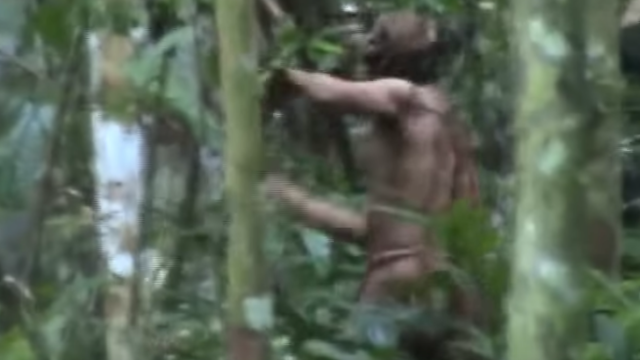An indigenous protection agency in Brazil has released footage of a man who has lived alone in the Amazon forest, in the state of Rondônia, for at least 22 years.
The man, reportedly in his 50s, is believed to be the last survivor of his tribe after a small group of six was killed by farmers in 1995, following years of attacks from local loggers and private farmers that decimated the population.
It is believed that the man has never spoken with anyone outside of his tribe, and the tribe’s name and language are unknown.
Brazilian media outlets refer to him as “the Hole Indian” and “indigenous man in the hole”. He is known to dig holes, likely for hiding and for trapping animals. Researchers found he fills holes with sharpened sticks to capture prey, and he placed a hammock over a hole inside his home.
The government agency Funai (Fundação Nacional do Índio) has been monitoring the man since it first found him in 1996. The group’s policy is to avoid contact, so it has been observing the man from afar all these years. The group most recently found evidence of his presence in May.
The group captured shaky footage of the the man chopping a tree in 2011, but only released it publicly last week.
Altair Algayer, Funai regional coordinator who is on the team that filmed the man, told The Guardian he is in good health. “He is very well, hunting, maintaining some plantations of papaya, corn,” Algayer said.
Algayer told the outlet that people have left the man seeds used by indigenous people and tools. But aside from using some of these offerings, he apparently wants little to do with the outside world, and has shot arrows at people who have gotten too close.
“It is his sign of resistance, and a little repudiation, hate, knowing the story he went through,” Algayer said.
A restriction order protects the man’s area — about 40km2, according to the BBC. But in order to uphold that protection, Funai has to continue to prove the man is alive, Fiona Watson, head researcher at Survival International, a tribal peoples’ rights advocacy group, told the BBC.
“There is also a political motivation for releasing the video,” she said. “Congress is dominated by agribusiness; Funai has had its budget slashed. There is a big assault on indigenous rights going on in the country.”
The man’s territory is surrounded by deforested areas and farms, and farmers seem eager to take over the land.
Algayer told The Sydney Morning Herald that the Funai team was hesitant to release the footage since it did not have the man’s consent. But the group ultimately decided the video would help protect the man as well as the land.
